Yanmin Qian
Advanced Zero-Shot Text-to-Speech for Background Removal and Preservation with Controllable Masked Speech Prediction
Feb 11, 2025Abstract:The acoustic background plays a crucial role in natural conversation. It provides context and helps listeners understand the environment, but a strong background makes it difficult for listeners to understand spoken words. The appropriate handling of these backgrounds is situation-dependent: Although it may be necessary to remove background to ensure speech clarity, preserving the background is sometimes crucial to maintaining the contextual integrity of the speech. Despite recent advancements in zero-shot Text-to-Speech technologies, current systems often struggle with speech prompts containing backgrounds. To address these challenges, we propose a Controllable Masked Speech Prediction strategy coupled with a dual-speaker encoder, utilizing a task-related control signal to guide the prediction of dual background removal and preservation targets. Experimental results demonstrate that our approach enables precise control over the removal or preservation of background across various acoustic conditions and exhibits strong generalization capabilities in unseen scenarios.
Generalizable Audio Deepfake Detection via Latent Space Refinement and Augmentation
Jan 24, 2025Abstract:Advances in speech synthesis technologies, like text-to-speech (TTS) and voice conversion (VC), have made detecting deepfake speech increasingly challenging. Spoofing countermeasures often struggle to generalize effectively, particularly when faced with unseen attacks. To address this, we propose a novel strategy that integrates Latent Space Refinement (LSR) and Latent Space Augmentation (LSA) to improve the generalization of deepfake detection systems. LSR introduces multiple learnable prototypes for the spoof class, refining the latent space to better capture the intricate variations within spoofed data. LSA further diversifies spoofed data representations by applying augmentation techniques directly in the latent space, enabling the model to learn a broader range of spoofing patterns. We evaluated our approach on four representative datasets, i.e. ASVspoof 2019 LA, ASVspoof 2021 LA and DF, and In-The-Wild. The results show that LSR and LSA perform well individually, and their integration achieves competitive results, matching or surpassing current state-of-the-art methods.
SLIDE: Integrating Speech Language Model with LLM for Spontaneous Spoken Dialogue Generation
Jan 01, 2025



Abstract:Recently, ``textless" speech language models (SLMs) based on speech units have made huge progress in generating naturalistic speech, including non-verbal vocalizations. However, the generated speech samples often lack semantic coherence. In this paper, we propose SLM and LLM Integration for spontaneous spoken Dialogue gEneration (SLIDE). Specifically, we first utilize an LLM to generate the textual content of spoken dialogue. Next, we convert the textual dialogues into phoneme sequences and use a two-tower transformer-based duration predictor to predict the duration of each phoneme. Finally, an SLM conditioned on the spoken phoneme sequences is used to vocalize the textual dialogue. Experimental results on the Fisher dataset demonstrate that our system can generate naturalistic spoken dialogue while maintaining high semantic coherence.
Scale This, Not That: Investigating Key Dataset Attributes for Efficient Speech Enhancement Scaling
Dec 19, 2024



Abstract:Recent speech enhancement models have shown impressive performance gains by scaling up model complexity and training data. However, the impact of dataset variability (e.g. text, language, speaker, and noise) has been underexplored. Analyzing each attribute individually is often challenging, as multiple attributes are usually entangled in commonly used datasets, posing a significant obstacle in understanding the distinct contributions of each attribute to the model's performance. To address this challenge, we propose a generation-training-evaluation framework that leverages zero-shot text-to-speech systems to investigate the impact of controlled attribute variations on speech enhancement performance. It enables us to synthesize training datasets in a scalable manner while carefully altering each attribute. Based on the proposed framework, we analyze the scaling effects of various dataset attributes on the performance of both discriminative and generative SE models. Extensive experiments on multi-domain corpora imply that acoustic attributes (e.g., speaker and noise) are much more important to current speech enhancement models than semantic attributes (e.g., language and text), offering new insights for future research.
Memory-Efficient Training for Deep Speaker Embedding Learning in Speaker Verification
Dec 02, 2024Abstract:Recent speaker verification (SV) systems have shown a trend toward adopting deeper speaker embedding extractors. Although deeper and larger neural networks can significantly improve performance, their substantial memory requirements hinder training on consumer GPUs. In this paper, we explore a memory-efficient training strategy for deep speaker embedding learning in resource-constrained scenarios. Firstly, we conduct a systematic analysis of GPU memory allocation during SV system training. Empirical observations show that activations and optimizer states are the main sources of memory consumption. For activations, we design two types of reversible neural networks which eliminate the need to store intermediate activations during back-propagation, thereby significantly reducing memory usage without performance loss. For optimizer states, we introduce a dynamic quantization approach that replaces the original 32-bit floating-point values with a dynamic tree-based 8-bit data type. Experimental results on VoxCeleb demonstrate that the reversible variants of ResNets and DF-ResNets can perform training without the need to cache activations in GPU memory. In addition, the 8-bit versions of SGD and Adam save 75% of memory costs while maintaining performance compared to their 32-bit counterparts. Finally, a detailed comparison of memory usage and performance indicates that our proposed models achieve up to 16.2x memory savings, with nearly identical parameters and performance compared to the vanilla systems. In contrast to the previous need for multiple high-end GPUs such as the A100, we can effectively train deep speaker embedding extractors with just one or two consumer-level 2080Ti GPUs.
Prototype and Instance Contrastive Learning for Unsupervised Domain Adaptation in Speaker Verification
Oct 22, 2024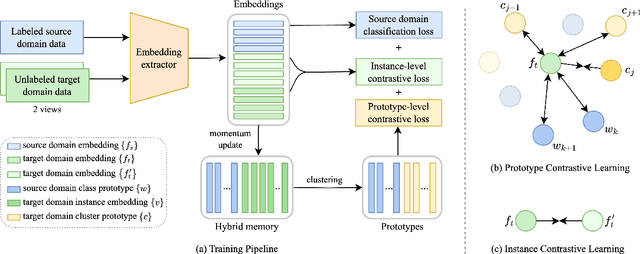
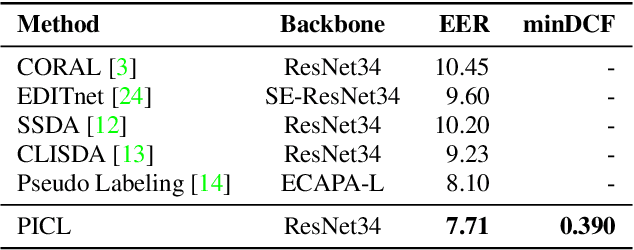
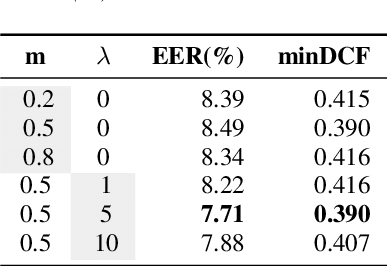
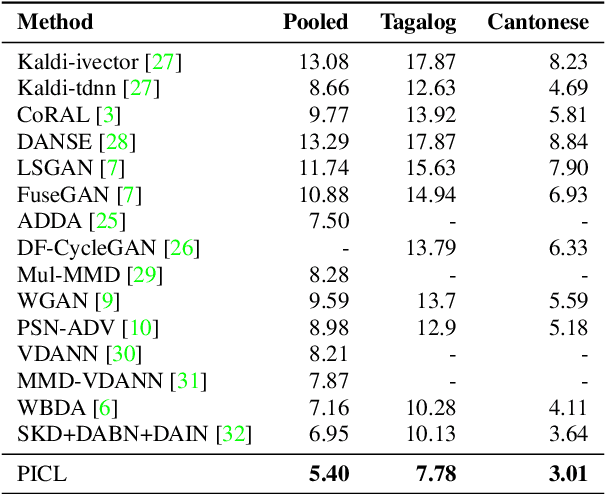
Abstract:Speaker verification system trained on one domain usually suffers performance degradation when applied to another domain. To address this challenge, researchers commonly use feature distribution matching-based methods in unsupervised domain adaptation scenarios where some unlabeled target domain data is available. However, these methods often have limited performance improvement and lack generalization in various mismatch situations. In this paper, we propose Prototype and Instance Contrastive Learning (PICL), a novel method for unsupervised domain adaptation in speaker verification through dual-level contrastive learning. For prototype contrastive learning, we generate pseudo labels via clustering to create dynamically updated prototype representations, aligning instances with their corresponding class or cluster prototypes. For instance contrastive learning, we minimize the distance between different views or augmentations of the same instance, ensuring robust and invariant representations resilient to variations like noise. This dual-level approach provides both high-level and low-level supervision, leading to improved generalization and robustness of the speaker verification model. Unlike previous studies that only evaluated mismatches in one situation, we have conducted relevant explorations on various datasets and achieved state-of-the-art performance currently, which also proves the generalization of our method.
WeSep: A Scalable and Flexible Toolkit Towards Generalizable Target Speaker Extraction
Sep 24, 2024



Abstract:Target speaker extraction (TSE) focuses on isolating the speech of a specific target speaker from overlapped multi-talker speech, which is a typical setup in the cocktail party problem. In recent years, TSE draws increasing attention due to its potential for various applications such as user-customized interfaces and hearing aids, or as a crutial front-end processing technologies for subsequential tasks such as speech recognition and speaker recongtion. However, there are currently few open-source toolkits or available pre-trained models for off-the-shelf usage. In this work, we introduce WeSep, a toolkit designed for research and practical applications in TSE. WeSep is featured with flexible target speaker modeling, scalable data management, effective on-the-fly data simulation, structured recipes and deployment support. The toolkit is publicly avaliable at \url{https://github.com/wenet-e2e/WeSep.}
Improving Anomalous Sound Detection via Low-Rank Adaptation Fine-Tuning of Pre-Trained Audio Models
Sep 11, 2024Abstract:Anomalous Sound Detection (ASD) has gained significant interest through the application of various Artificial Intelligence (AI) technologies in industrial settings. Though possessing great potential, ASD systems can hardly be readily deployed in real production sites due to the generalization problem, which is primarily caused by the difficulty of data collection and the complexity of environmental factors. This paper introduces a robust ASD model that leverages audio pre-trained models. Specifically, we fine-tune these models using machine operation data, employing SpecAug as a data augmentation strategy. Additionally, we investigate the impact of utilizing Low-Rank Adaptation (LoRA) tuning instead of full fine-tuning to address the problem of limited data for fine-tuning. Our experiments on the DCASE2023 Task 2 dataset establish a new benchmark of 77.75% on the evaluation set, with a significant improvement of 6.48% compared with previous state-of-the-art (SOTA) models, including top-tier traditional convolutional networks and speech pre-trained models, which demonstrates the effectiveness of audio pre-trained models with LoRA tuning. Ablation studies are also conducted to showcase the efficacy of the proposed scheme.
Disentangling the Prosody and Semantic Information with Pre-trained Model for In-Context Learning based Zero-Shot Voice Conversion
Sep 10, 2024Abstract:Voice conversion (VC) aims to modify the speaker's timbre while retaining speech content. Previous approaches have tokenized the outputs from self-supervised into semantic tokens, facilitating disentanglement of speech content information. Recently, in-context learning (ICL) has emerged in text-to-speech (TTS) systems for effectively modeling specific characteristics such as timbre through context conditioning. This paper proposes an ICL capability enhanced VC system (ICL-VC) employing a mask and reconstruction training strategy based on flow-matching generative models. Augmented with semantic tokens, our experiments on the LibriTTS dataset demonstrate that ICL-VC improves speaker similarity. Additionally, we find that k-means is a versatile tokenization method applicable to various pre-trained models. However, the ICL-VC system faces challenges in preserving the prosody of the source speech. To mitigate this issue, we propose incorporating prosody embeddings extracted from a pre-trained emotion recognition model into our system. Integration of prosody embeddings notably enhances the system's capability to preserve source speech prosody, as validated on the Emotional Speech Database.
Flow-TSVAD: Target-Speaker Voice Activity Detection via Latent Flow Matching
Sep 07, 2024
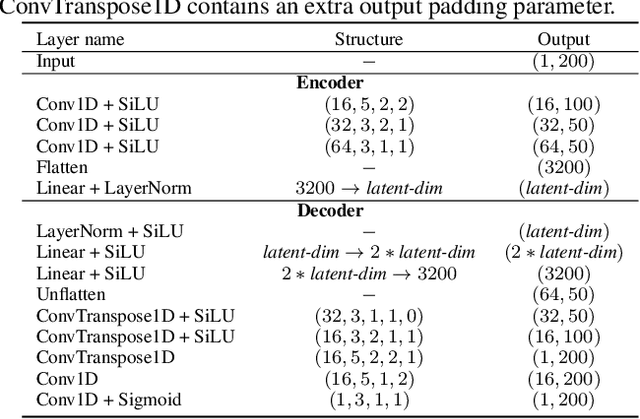

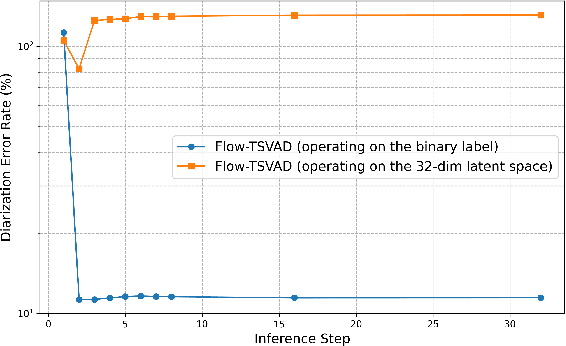
Abstract:Speaker diarization is typically considered a discriminative task, using discriminative approaches to produce fixed diarization results. In this paper, we explore the use of neural network-based generative methods for speaker diarization for the first time. We implement a Flow-Matching (FM) based generative algorithm within the sequence-to-sequence target speaker voice activity detection (Seq2Seq-TSVAD) diarization system. Our experiments reveal that applying the generative method directly to the original binary label sequence space of the TS-VAD output is ineffective. To address this issue, we propose mapping the binary label sequence into a dense latent space before applying the generative algorithm and our proposed Flow-TSVAD method outperforms the Seq2Seq-TSVAD system. Additionally, we observe that the FM algorithm converges rapidly during the inference stage, requiring only two inference steps to achieve promising results. As a generative model, Flow-TSVAD allows for sampling different diarization results by running the model multiple times. Moreover, ensembling results from various sampling instances further enhances diarization performance.
 Add to Chrome
Add to Chrome Add to Firefox
Add to Firefox Add to Edge
Add to Edge